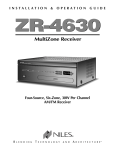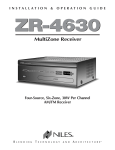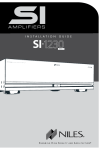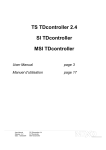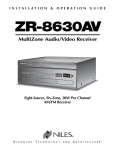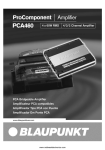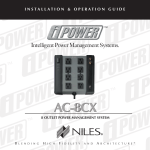Download Niles Audio SI-1260 Stereo Amplifier User Manual
Transcript
INSTALLATION & OPERATION GUIDE Systems Integration Amplifier ® ® B L E N D I N G H I G H F I D E L I T Y A N D A R C H I T E C T U R E® CONGRATULATIONS! Thank you for purchasing the Niles SI-1260 Systems Integration Amplifier, one of the most versatile and powerful multi-channel amplifiers ever offered. Like all Niles products, the SI-1260 is built to the highest standards of quality and reliability. With proper installation and operation, you'll enjoy years of trouble-free use. Niles manufactures the industry's most complete line of custom installation components and accessories for audio/video systems. For a free full-line catalog write: Niles, Catalog Request, P.O. Box 160818, Miami, Florida 33116-0818 or visit www.nilesaudio.com. TABLE OF CONTENTS 1 INTRODUCTION 2 FEATURES AND BENEFITS 3 SYSTEM DESIGN BASICS 5 SYSTEM DESIGN CONSIDERATIONS 6 APPLICATIONS 8 CONFIGURING YOUR SYSTEM 13 INSTALLATION CONSIDERATIONS 14 INSTALLATION 16 FRONT & REAR PANEL DETAILS 17 OPERATION 23 TROUBLESHOOTING GUIDE 27 CONFIGURATION WORKSHEET 29 SPECIFICATIONS 30 Designed for use in high-end/high-powered distributed audio systems, the SI-1260 Systems Integration Amplifier provides a level of performance, flexibility, and ease of installation previously unavailable to custom installers. The SI-1260's unique design enables each of its channels to be independently configured to reproduce stereo or mono in any combination, as well as to compensate for differing volume levels in rooms of different sizes. Additionally, the amplifier's Dual Bus Matrix™ feature and multiple inputs enable it to be used in several different applications simultaneously if desired (i.e. mono background music in some rooms and stereo in others). INTRODUCTION INTRODUCTION As you read this manual and become more familiar with the SI-1260's capabilities, you will understand why our multi-channel amplifier design has won many prestigious industry awards. The first multi-channel amplifier introduced by Niles, the SI1200, was selected Best New Product in 1994 by both Sound & Video Contractor Magazine and the Custom Electronic Design and Installation Association (CEDIA). In addition, the SI-1200 also won the Consumer Electronics Show's Innovations '95 Design and Engineering Award. SI-1260 Systems Integration Amplifier Figure 1 2 FEATURES AND BENEFITS FEATURES AND BENEFITS Microcontroller Based Real World Power The SI-1260 12 channel amplifier incorporates microcontroller technology which maximizes the amplifier's operational efficiency and enables it to deliver a solid 60 watts per channel into 8 ohms, 20Hz to 20kHz, 0.04% THD. Its power increases to 80 watts per channel into 4 ohms, 20Hz to 20kHz, at 0.06% THD. The massive Multi-Tap Toroid power transformer features 6 independent secondary windings, one for each of the six amplifier modules. This extraordinary power supply design provides the power necessary to deliver solid, deep, controlled bass response to a house full of speakers. Transparent Sound The audio circuitry of the SI-1260 is constructed with the finest parts available including the latest in discrete output transistor design, featuring 1% metal film resistors, high quality capacitors and oversized heat sinks. All this attention to technical detail results in a sound that is clear and uncolored. Microcontroller Based Operation and Protection Modes The SI-1260 utilizes advanced microcontroller based operation circuitry that monitors all facets of the amplifier's operation and protection modes: over/under line voltage, main power fuse status, channel pair on/off status, thermal protection, short circuit/low impedance protection and DC output protection. Additionally, easy to see front panel LED indicators display the operation or protection mode for each channel pair (CH1/2, CH3/4, CH5/6, CH7/8, CH9/10 and CH11/12) as well as for the amplifier's main power supply, providing fast and easy troubleshooting. In the unlikely event that a problem occurs on one channel pair, the other channels will continue to play. When conditions return to normal, regular operation will resume. Dual Input BusMatrix™ Selector Nile’s unique Dual Input BusMatrix™ selector gives you the flexibility to individually assign each amplifier channel to a BusMatrix™ input signal, either Left1, Right1, Left1+Right1, Left2, Right2, Left2+Right2, or to a dedicated signal input. With the BusMatrix™, routing surround sound to the master bedroom, stereo to the den, and mono to a bathroom is as simple as flicking a switch. The Dual Input BusMatrix™ makes the SI-1260 an ideal multi-room or multi-zone amplifier, offering the professional installer exciting new features and sound system design possibilities. 3 Each of the SI-1260's six adjacent output pairs are bridgeable. You can create up to six 120-watt channels by setting the bridging switch to the "BRIDGED" position. These switches are located at the top of the rear panel (see Page 21 Figure 16). Bridging enables you to double the power to specific speaker locations, including large rooms and outdoor applications. Freedom From Noise and Cross-Talk The unique design of the SI-1260's Dual Input BusMatrix™ PC board ensures extremely high channel-to-channel isolation. Signal-to-noise ratio and cross-talk specifications are comparable to those of mixing consoles used in professional recording studios. With the SI-1260, the music playing in the living room will not interfere with the music playing in the den. FEATURES AND BENEFITS Twelve to Six Channel Configurable Power Independent Level Controls Each channel has its own independent volume level control, enabling you to individually adjust the setting for up to twelve different speaker locations for optimum audio performance, providing uniform sound in every room. Turn-On Modes The SI-1260 features three selectable turn-on modes: (1) manual turn-on via the front panel switch, (2) microcontroller enhanced audio sensing which activates only the appropriate amplifier channels while leaving unused channel pairs off to eliminate cross talk and (3) a 3-30 volt AC/DC voltage trigger input which enables voltage activation. Audio Sense and External Voltage trigger modes enable you to configure the SI-1260 to turn on automatically in any kind of system configuration. DB25 Audio & Voltage Trigger inputs The SI-1260 incorporates a DB25 input connector to reduce wiring and installation time when using Niles Systems Integration Electronics. Niles multi-zone preamplifiers are equipped with a mating DB25 output connector. This output connector provides 6 zones of line-level audio signal output and a 12V Trigger Voltage for reliable amplifier activation. Designed in the USA The Niles SI-1260 was designed in the USA by Niles engineers and includes a two year parts and labor warranty. 4 SYSTEM DESIGN BASICS SYSTEM DESIGN BASICS As shown in Figure 2, a distributed audio/video system is defined by the number of listening zones it has. Within a listening zone you can listen to only one (1) source (e.g. CD, Radio, Tape, etc.) at any one time. A listening zone can consist of a single room or a group of rooms. To achieve different volumes and greater convenience in different rooms within a zone, individual volume controls can be used. Niles makes volume controls in various styles and colors. When designing your system, take into account who will use the system and when they will use it. Consult your local Niles dealer for more information. A multi-zone system as shown in Figure 3, offers the household more flexibility. For instance, a family might have their family room wired for surround sound and their living room wired for background music. In a two zone system, the children can watch TV in surround sound while Mom and Dad are reading the paper and enjoying background music in the living room. TAPE PLAYER CD PLAYER VCR TV A Single-Zone System allows only one source to be heard throughout the house at a given time. RECEIVER FAMILY ROOM LIVING ROOM LISTENING ZONE 1 Figure 2 - Single Zone System TAPE PLAYER CD PLAYER VCR TV RECEIVER RECEIVER LIVING ROOM FAMILY ROOM LISTENING ZONE 1 LISTENING ZONE 2 Figure 3 - Multi-Zone System 5 Speaker Compatibility A single channel (not bridged) of the SI-1260 is capable of driving a low impedance speaker load. As many as three eight ohm speakers can be safely connected to a single channel, presenting the amplifier a 2.66 ohm load. Proper ventilation of the SI-1260 is critical when driving low impedance loads. If the SI-1260 is not properly ventilated, the protection circuits may activate and shut off the channel at higher volume levels (for more information on proper amplifier placement, see Installation Considerations on page 14). A channel pair that has been BRIDGED is capable of driving an impedance load of 4 ohms. Proper ventilation of the SI-1260 is critical when driving a 4 ohm load with bridged channels. If the SI-1260 is not properly ventilated, the protection circuits may activate and shut off the channel at higher volume levels (for more information on proper amplifier placement, see Installation Considerations on page 14). SYSTEM DESIGN CONSIDERATIONS SYSTEM DESIGN CONSIDERATIONS When designing your system, try to specify 6-8 ohm speakers (Niles offers a complete line of in-wall, in-ceiling, outdoor and home theater loudspeakers with all models rated from 6-8 ohms). Cable and Wire Because the SI-1260 has many connections on the rear panel (see Figure 13), it is important that you correctly label all of the input cables and speaker wires. Label the cables and wires with their destination or source, rather than the SI-1260 terminal to which they are connected. This will make it easier to reconfigure your system in the future. The SI-1260 connects to your sources via shielded line level audio cables with RCA connectors. Use high quality cables with your Niles amplifier for the lowest possible noise and best overall performance. Your Niles dealer can recommend the proper cable. A DB25 Multi-Zone Input Connector is provided for use with Niles Multi-Zone Products which include a mating DB25 output connector. All 12 dedicated inputs are included within the single connector, along with the SI-1260's Voltage Trigger Input. The SI-1260 connects to your speakers using two conductor speaker wire. For most applications, we recommend you use 16 or 18 gauge wire. For wiring runs longer than 80 feet, we recommend 14 gauge wire. The SI-1260's high-quality, gold-plated 5-way binding posts will accommodate up to 12-gauge wire. Attaching banana plugs to the wire will enable the connection of larger wire sizes. 6 SYSTEM DESIGN CONSIDERATIONS Using Mono For Smoother Coverage In large or irregularly shaped rooms, you may find that the main listening area may be closer to one of the speakers. If the speakers in the room are connected to a stereo amplifier you will only hear half the music. The SI-1260's BusMatrix™ enables you to create mono sound from one speaker without impacting the stereo quality in the rest of the system. You can configure each room to either stereo or mono as needed with no ill effects. Some of the most popular areas where mono will greatly enhance the sound quality would be: • Large rooms with many seating areas and/or many pairs of speakers. • Irregularly shaped rooms. • Bathrooms with one speaker over the tub and one speaker over the sink(s). • Hallways or passageways (including those with multiple speakers). • Small rooms, such as walk-in closets where more than a single speaker is not required. Bridging Channels for Areas that Require More Volume and Power There are several situations where bridging is an excellent way to improve the sound. There are also applications where bridging would seem to be appropriate but is not recommended. Bridging channels increases the power to 120 watts per channel with an 8 ohm impedance. These are some of the most common Do's and Don'ts: 1. Outdoors (DO) - Sound dissipates faster outside than it does in a room where the walls enclose the sound and reflect it back to the listener. A pair of speakers playing into a large patio or yard will greatly benefit from bridging four channels into two 120 watt channels. 2. Surround Sound Systems (DO) - The dynamic demands for the center channel are much greater than the left, right or surround channels. This is an excellent application for two channels to be bridged into one 120 watt channel. 3. More than one pair of 8-ohm speakers (DON'T) - In a large room or a long hallway, often the best way to get good background music is to install multiple pairs of speakers. You will actually deliver more power to two pairs of 8 ohm speakers by using two unbridged amplifier channels than you would if you bridged four amplifier channels into two and connected the two pairs of speakers in parallel. 7 Advantages of Using The SI-1260 in a Single Zone System By connecting a Niles SI-1260 to a stereo receiver's preamplifier outputs, you dedicate a robust 60 watts to each speaker in your multi-room system. Each channel has its own level control, enabling you to compensate for architectural differences which may cause one speaker to seem louder than another. In addition, you can fine tune the system so that when all of the room volume controls are set to the loudest level, the large rooms and the small rooms play at the same volume. DSS VCR APPLICATIONS APPLICATIONS CD Preamplifier or AM/FM receiver SI-1260 Niles VCS-2D Volume Control Room 1 Room 2 Room 3 Room 4 Room 5 Room 6 Single Zone Figure 4 - Single Zone 8 APPLICATIONS & SYSTEM DESIGN CONSIDERATIONS Creating a Low-Cost Second Zone Using A Dedicated Source The main problem in a single zone system is that when a source is being listened to in one room, you cannot listen to another source in another room simultaneously. However, for a listener who only listens to CDs, a low-cost second zone may be created to allow simultaneous CD listening while the main system is playing another source. This is possible only if the CD player you are using has dual audio outputs, one with remote controllable volume and the other a fixed volume. As shown in Figure 5, you connect the CD player's variable output to the SI-1260's dedicated channel inputs for the particular room where you will listen only to CDs. The fixed output is connected to the main preamp or receiver so you can also listen to CDs in the rest of the house. The finishing touch is to install a Niles infrared repeater system (IRR-4D, IRP-2+ and IRC-2) so you may adjust the CD player's volume via remote control from your CD listening room. DSS VCR CD (Fixed) Preamplifier or AM/FM receiver IRC-2 (Variable) BusMatrix™ Input 1 BusMatrix™ Input 2 I SI-1260 FLASHERS Niles VCS-2D Volume Control IRP-2+ Niles IRR-4D+ IR Sensor ZONE 1 Figure 5 - Low Cost Second Zone for CDs 9 ZONE 2 Most of today's Dolby Digital surround sound receivers include a second zone preamplifier output used to create a second listening zone. Using this output with one of the SI-1260's BusMatrix™ inputs provides amplification for multiple rooms within a second listening zone as shown in Figure 6. DVD/CD CHANGER VCR DSS APPLICATIONS Using A Dual-Zone Receiver for Two Listening Zones Second Zone Output Dual Zone Surround Sound Receiver ZONE 1 (Home Theater) Front Speakers Center Speaker Rear Speakers BusMatrix Input 1 ™ Niles VCS-2D Volume Control Living Room Niles VCS-2D HP Volume Control (HP = High Power) SI-1260 Kitchen Exercise Room (Unbridged Channels1-8) Hallway Patio (Bridged Channels 9-10, 11-12) Figure 6 - Using a Dual Zone Receiver 10 Adding Preamps To Create More Listening Zones APPLICATIONS & SYSTEM DESIGN CONSIDERATIONS In the ultimate multi-zone system, you would connect six stereo preamplifiers (or a single component multi-zone/multi-source preamplifier) to one SI-1260, creating six completely independent listening zones. Multi-zone systems enable listeners located in six separate zones to simultaneously listen to different source components as shown in Figure 7. AM/FM TUNER DSS DVD/CD CHANGER Niles A4.6Ci Zone Outputs Dedicated Inputs SI-1260 ZONE 1 ZONE 2 ZONE 3 ZONE 4 ZONE 5 Figure 7 - Creating More Listening Zones 11 ZONE 6 Utilizing the Dual BusMatrix™ Input DVD/CD CHANGER AM/FM TUNER DSS Zones 3-6 ZONE 3 SI-1260 Niles A4.6Ci Zones 1-2 BusMatrix™ Input 1 BusMatrix™ Input 2 ZONE 4 SI-1260 Niles VCS-2D Volume Control ZONE 5 ROOM 1 ROOM 2 ZONE 1 ROOM 3 ROOM 4 ROOM 5 ZONE 2 APPLICATIONS & SYSTEM DESIGN CONSIDERATIONS Many multi-zone systems incorporate multiple rooms within a single zone. The SI-1260’s Dual BusMatrix™ Input simplifies the connections required for this system design. As shown in Figure 8, a Niles A4.6Ci Multi-zone Controller has its first and second zone outputs connected to the SI-1260’s Dual BusMatrix™ #1 and #2 inputs respectively. Bus Input #1 is then routed to amplifier channels one through six via dip switch settings. Bus Input #2 is routed to amplifier channels seven through twelve in the same manner. Six rooms can now be connected to the SI-1260 placing three rooms in Zone #1 and three rooms in Zone #2. The remaining zone outputs on the A4.6Ci can be connected to another SI-1260 for more zones. ROOM 6 ZONE 6 Figure 8 - Dual BusMatrix™ Input 12 CONFIGURING YOUR SYSTEM CONFIGURING YOUR SYSTEM The SI-1260 offers many configuration possibilities. Therefore, carefully plan the installation before starting. Start by drawing a block diagram of your system and use the Configuration Worksheet on page 29 to document how you plan to connect your SI-1260. Figure 9, shown below, is an example of a Configuration Worksheet filled out according to the block diagram (figure 6) on page 10. Figure 9 Sample Configuration Worksheet BUS INPUTS & OUTPUTS Second Zone Left Output Right Bus Input # 1 Second Zone Right Output Left Bus Input # 2 N/S Right Bus Input # 2 N/S Cascade Output Bus # 1 Right N/S Cascade Output Bus # 1 Left N/S Cascade Output Bus # 2 Right N/S Cascade Output Bus # 2 Left N/S CH # BRIDGED 1 2 3 4 5 6 7 8 9 10 11 ✓ ✓ 12 MODE SETTINGS Constant Audio Sense Voltage Trigger Control Output 13 CONNECTED TO. . . Left Bus Input # 1 DIP L1 R1 L1 R1 L1 R1 L1+R1 L1+R1 Off L1 Off R1 IN USE ✓ INPUT SOURCE SPEAKER Bus #1 Bus #1 Bus #1 Bus #1 Bus #1 Bus #1 Bus #1 Bus #1 N/S Bus #1 N/S Bus #1 Left Living Room Right Living Room Left Kitchen Right Kitchen Left Exercise Room Right Exercise Room Hallway #1 Hallway #2 N/S Left Patio N/S Right Patio SPECIAL CONNECTIONS OR NOTES Automating the turn-on of your SI-1260 is one of the easiest steps when installing it in a distributed system. However, do not plug the main power cord into the switched AC outlet of your preamplifier or receiver. The high power design of the SI-1260 requires large amounts of current from its AC power source. Additionally, it is always recommended to activate the system preamplifier/receiver before turning on your SI-1260 in order to prevent system “turn-on thumps”. In order to address these important needs, the SI-1260 has three special turn-on modes that let you turn the amplifier on only when it is needed. These three options are accessed by the TurnOn Mode selector switch (see Figure 10). Important! The Front Panel Power Switch must be in the ON (switch in) position for any of the three turn-on options to function (refer to page 23 for more information concerning the Front Panel Power Switch). Turn-On Modes INSTALLATION CONSIDERATIONS INSTALLATION CONSIDERATIONS Constant: The auto turn-on circuitry is "OFF". The front panel master power switch operates the amplifier. When the switch is in, the amp is "ON", when it is out, the amp is "OFF". Audio Sense: The amplifier is "OFF" when there is no audio signal present at any of the 16 inputs, but the sensing circuitry is active. The turn-on sensing circuitry looks for a tiny amount of audio signal present at any of the audio inputs. If it detects a signal, the adjacent Figure 10 - Turn-On Mode. pair of amplifier channels (i.e. channel 1/2, 3/4, 5/6, etc.) assigned to receive the input signals will switch "ON". Once the audio signal stops, the sensing circuit waits approximately 2-minutes, then switches all amplifier channels "OFF". 3-30V AC/DC Trigger Input: The amplifier is "OFF" when a 3 to 30-Volt AC or DC signal is not applied to the voltage trigger input. Once the sensing circuitry detects such a voltage, all adjacent pairs of amplifier channels that are receiving an audio signal switch "ON". Once the voltage is removed, the Voltage Trigger circuit instantly switches the amplifier "OFF". Voltage triggers may be supplied by Niles automated switchers, some video projectors, some surround sound processors, or a 12 Volt DC wall adapter (Niles FG00665) plugged into the switched outlet of your stereo receiver. If you are using a wall adapter or external power supply to provide the trigger, it doesn't have to be very large (a minimum current capability of 2.5-milliamps for a 3 Volt trigger increasing up to a minimum of 38 milliamps for a 30-Volt trigger). 14 INSTALLATION CONSIDERATIONS Placement CAUTION! Placing the SI-1260’s weight on the rear or front panels will cause damage to the amplifier’s connectors or controls. Place the SI-1260 on a flat, level surface like a table or shelf. The SI-1260 must be placed with its weight equally distributed on the unit's four feet. This amplifier, like any high-fidelity component, will last much longer if it is given adequate ventilation for proper cooling. When installing the SI-1260 in a cabinet, be sure that the cabinet's rear is open to fresh air (see Figure 11). Additionally, place the SI-1260 so that there are at least 6 inches of free air space above the amplifier and 1 inch on each side. If the amplifier is located on a carpeted surface, place a board under the amplifier's feet. If the cabinet's design will not accommodate an open rear, install two small "boxer fans" to provide continuous air flow into and out of the cabinet (see Figure 12). CAUTION! When using low impedance speaker loads (less than 4 ohms Normal Mode, less than 8 ohms Bridged Mode), refer to figure 12 for proper placement. CAUTION! DO NOT block the ventilation holes on the top and bottom of the SI1260. The SI-1260 is equipped with a massive toroidal power transformer. This transformer generates a powerful magnetic field that could induce a hum in a turntable (particularly a turntable equipped with a moving coil cartridge). DO NOT place a turntable directly above or directly adjacent to the SI-1260. CAUTION! Before placing the SI-1260 on a shelf, verify that the weight bearing capacity of the shelf is 70 lbs or greater. Figure 11 Figure 12 Boxer Fan (105 CFM) directly centered 6” on top of the SI-1260. Boxer Fan (105 CFM) directly centered 2” behind the SI-1260. Make sure that there is a minimum of 6” of free air space above the amplifier and 1” on each side for proper ventilation. Allow a minimum of 2” of depth behind the unit to accommodate cables and connectors . 15 If the cabinet rear is not open to fresh air or if your using low impedance loads, install two “boxer fans” to provide continuous air flow into and out of the cabinet. Line Level Audio Inputs Caution! The amplifier must be off whenever you make changes to the input connections. STEP DESCRIPTION 1. Correctly label the interconnecting cables coming from each source. Use audio patch cables terminated with RCA connectors. 2. Connect the sources by inserting the RCA connectors into a BusMatrix™ input or dedicated input jack on the SI-1260's rear panel. Connect outputs from your source components to the input jacks on the amplifier. NEVER connect a preamplifier or source input (e.g., record inputs) to the SI-1260 inputs. INSTALLATION INSTALLATION NOTE: When you are using two amplifier channels in the "bridged" mode, assign the audio signal to be amplified to the EVEN numbered amplifier channel using the BusMatrix™ Dip Switches. Cascade Audio Outputs The "Cascade Audio Outputs" enable you to connect additional amplifiers to your preamplifier's output. Connection is accomplished with standard RCA interconnect cables. The outputs are not buffered; to daisy chain more than five Niles amplifiers you will need a Niles AVDA-3 buffered distribution amplifier. A single AVDA-3 enables you to daisy chain five amplifiers from each of three outputs. This allows 15 SI-1260 power amplifiers to be fed from the same master preamplifier. If your preamplifier has a vacuum tube output stage, you must use a Niles AVDA-3 to drive more than one SI-1260. AC Power Plug STEP DESCRIPTION 1. Plug the SI-1260’s attached 2 prong power cord into a correctly grounded 120 Volt, 60-Hz wall outlet. If you use a grounded power strip, surge protector, or extension cord, verify that the proper ground is maintained CAUTION! DO NOT PLUG THE SI-1260'S POWER CORD INTO A PREAMPLIFIER'S CONVENIENCE OUTLET. 1. The SI-1260 draws a maximum of about 890 watts from an AC wall outlet. This is much more than the typical accessory outlet on a component's rear panel can provide. 2. Use the SI-1260's auto turn-on circuitry to switch "ON" the SI-1260 when the preamplifier is "ON". 16 Figure 13 FRONT AND REAR PANEL DETAILS Red “Power” LED confirms the amplifier is connected to a live AC outlet and that the front panel switch is on. Additionally, it indicates any AC line voltage problems and main power fuse status. Front panel “Master Power” switch turns off the entire amplifier, including the auto turn on circuitry. Cascade outputs of the bus input enable you to daisy chain multiple amplifiers. BusMatrix™ controls for each channel. Gold Plated Dual Bus Inputs, selectable by the BusMatrix™, provide enhanced input flexibility. “Turn-On” Mode Switch. 3.5 mm Jack for 3-30V AC/DC trigger input. 3.5 mm Jack for 12v DC Control Output. (150 mA max) 17 Level controls for each channel. Bridging switch for each channel pair. Attractive extruded aluminum front panel. FRONT AND REAR PANEL DETAILS Multi-color “Channel Pair” LED indicators display channel pair on/off status, and protection modes. DB-25 input connector for simplified dedicated audio and voltage trigger connection using Niles Multi-Zone Products. Gold-plated RCA jacks for the dedicated inputs. Serial Number. Removable Two-prong IEC compatible AC power cord. Gold plated, dual banana plug spaced, five-way speaker binding posts. 18 Speaker Wire Connections INSTALLATION CAUTION! All speaker wire connections must be made with the amplifier OFF. Figure 14 - Binding Posts STEP DESCRIPTION 1. Label all wires. If all wires connecting to the SI-1260 are labeled with their destination rather than their specific connection to the SI-1260, it will be easier to reconfigure the system in the future. 2. Connect one stripped wire end or banana plug to the black terminal and one to the red terminal. A. Split the speaker wire insulation at least 2 inches. CAUTION! NOT EVEN A SINGLE STRAND OF WIRE CAN BE ALLOWED TO TOUCH THE AMPLIFIER CHASSIS OR ANOTHER CONNECTOR. 19 Banana Plugs There are many types of banana plugs available. Some are crimped onto the speaker wire and some are soldered. Niles offers banana plugs that have a quick-connect binding system for the speaker wire included within the banana plug itself. After the wire is attached, the banana plug is simply inserted into the hole at the end of the amplifier's speaker binding post. Dual spaced banana plugs will fit the SI-1260 binding posts. Bare Wire Unscrew the red or black plastic knobs and insert the bare wire through the hole in the post. Tighten the knob until the wire is securely clamped. B. Strip 1/2 inch of insulation from each speaker wire conductor. C. Attach banana plugs or twist the wire strands of each conductor and insert them into the appropriate SI-1260 binding post. BusMatrix™ Input DIP Switch Settings DIP Switch Settings 1L is for the assignment of the Left Bus Input #1 1R is for the assignment of Right Bus Input #1 1L+1R is for the assignment of a summed mono signal of the Left and Right Bus Input#1 2L is for the Left Bus Input #2 2R is for the Right Bus Input #2 2L+2R is for a summed mono signal of the Left and Right Bus Input #2 The seventh switch assigns the dedicated input to its respective channel Again, only one of the seven DIP switches should be configured to the "ON" position (switched to the right). INSTALLATION Each channel has a dedicated BusMatrix™ DIP switch bank that assigns that channel's source input signal (see Figure 15). To assign the BusMatrix™ source input signal for a particular channel, set only one of the seven switches to the right. “OFF” Position “ON” Position Figure 15 - BusMatrix™ DIP Switches STEP DESCRIPTION 1. Move only one (1) DIP switch to the "ON" position for each channel. CAUTION! EACH DIP SWITCH ALLOWS YOU TO MOVE ALL SEVEN SLIDE SWITCHES TO THE "ON" POSITION. IF YOU SET MORE THAN ONE SLIDE SWITCH TO "ON" YOU MAY CREATE AN UNDESIRABLE MIX OF INPUTS ON THE ENTIRE BUS. 20 Bridging Two Channels into One INSTALLATION The SI-1260's bridging switches allow you to create a more powerful amplifier channel by combining or "bridging" two adjacent amplifier channels together into one. Figure 16 Channel Bridging Switch and DIP Switches Slide the bridgWhen two channels are bridged ing switch in the together, connect speakers to the direction of the two terminals labeled “Bridged”. arrow to bridge two adjacent amplifier channels. Set the controls of the newly bridged pair by using the EVEN numbered channel. STEP DESCRIPTION 1. Choose which of the six pairs you wish to bridge and move the bridging switch for that pair to the "Bridged" position (toward arrow). The 12 channels are grouped into 6 pairs (e.g. 1 & 2). Only the two channels within a pair can be bridged. Thus, only channels 1 and 2, or channels 3 and 4 could be bridged. Channel 2 and 3 are not a pair and cannot be bridged. CAUTION! DO NOT CONNECT A SPEAKER LOAD OF LESS THAN 4 OHMS TO A BRIDGED CHANNEL. Each bridged channel is designed for a 4 ohm minimum load. Connecting multiple speakers to a single channel, creating a nominal impedance of less than 4 ohms may cause the SI-1260 to go into protection mode or be damaged. 2. Connect the speaker wires to the two bridged speaker terminals (BRIDGED+, BRIDGED-). Carefully observe the polarity markings. Connect the speaker wires to the two adjacent amplifier channel's RED terminals only. NOTE: If one of the speaker wires touches a BLACK terminal, you will short-circuit the amplifier. CAUTION! DO NOT CONNECT A HEADPHONE JUNCTION BOX TO THE OUTPUT OF A BRIDGED CHANNEL PAIR. 3. Use the EVEN NUMBERED BusMatrix™ switch bank and level control for the adjustments and configuration of a bridged channel. 21 Figure 17 Bridged Channel Connections These connections to a bridged channel pair will cause either thermal shutdown or poor quality sound. When two channels are bridged into one, ensure that the odd numbered DIP switches are all in the "OFF" position. Setting the Turn-On Mode Switch Figure 18 Slide the switch with either your fingernail or a 1/8” slotted screwdriver blade. The Control Output INSTALLATION The SI-1260 has three (3) turn-on modes. Select the desired mode by sliding the mode switch to the proper position. See Installation Considerations on page 14 and Figure 10 for more information about each of the turn-on modes. Figure 19 As shown in Figure 19, a 3.5 mm female miniplug output jack on the rear panel of the SI-1260 provides a 12V DC trigger signal. It is suitable for triggering Niles automated switchers, some motorized screens and electric curtain controls and other devices that require a constant 12V DC control voltage for activation. Using the 3.5 mm jack. This voltage is provided only when any of the amplifier channels are active or "ON". When all amplifier channels are "OFF", the 12V signal is "OFF". STEP DESCRIPTION 1. Check the requirements of the device you want to control. The control output provides 150 mA of current maximum. 2. Connect the 3.5mm jack to the control output maintaining proper polarity (tip = +) Niles makes an accessory cable plug FG00724. 22 OPERATION OPERATION Front Panel Power Switch The SI-1260's master power switch is located on the front panel. Pressing the switch toggles between the ON (switch in) and the OFF (switch out) position. It must be in the ON position to enable the amplifier to activate regardless of the turn-on mode selected (see page 14). If you are going on vacation and/or would like to reduce power consumption while you are away, set the master power switch to the OFF position. When you would like to return to normal operation, set the switch back to the ON position. Power LED Indicator The SI-1260 features a bi-colored POWER LED indicating the power status of the amplifier: POWER LED STATUS OFF Amplifier is not plugged in to a live AC outlet. Solid Yellow The amplifier is plugged into a live AC outlet and the main power switch is OFF (out position). Solid Red The amplifier is plugged into a live AC outlet and the main power switch is ON (in position). Fast Red Blinking The AC line voltage is above or below the normal 120VAC. This will cause the amplifier to turn off. (Three Times Per Second) Normal operation resumes once the AC line voltage returns to 120VAC. Slow Red Blinking (Once Every Three Seconds) 23 Internal defect. The amplifier should be returned to Niles for service. The SI-1260 incorporates individual multi-colored LEDs for each channel-pair that indicate the following: CHANNEL PAIR LED STATUS OFF The channel pair is OFF. Solid Green The channel pair is active and operating normally. Fast Red Blinking Indicates a possible short circuit or low impedance condition. Speaker wire strands that are touching at the speaker or the amplifier's speaker terminals and/or a damaged speaker wire can cause a short circuit. More than three pairs of 8 ohm speakers attached to the same amplifier channel present the amplifier channel with a low impedance. Both of these conditions will cause the LED indicator to blink red very quickly. Eliminating the short circuit or connecting a proper speaker impedance load will enable the channel pair to resume normal operation. (Three Times Per Second) Slow Red Blinking (Once Every Three Seconds) Solid Red OPERATION Channel Pair LED Indicators Indicates the channel pair is overheating due to inadequate ventilation. Providing proper airflow to the amplifier will eliminate this problem (refer to page 15, figures 11 and 12 for amplifier placement details). There is a damaged internal component in this channel pair module. The amplifier should be returned to Niles for service. 24 OPERATION Using Level Controls as Limiters Using the individual level controls, the SI-1260 enables you to set a specific volume level for each of the different rooms connected. Individual room volume levels can be calibrated so that all rooms have similar volume control characteristics regardless of size and acoustics and to establish a maximum volume level. This is especially useful if your system is remote controlled, or if some of the users like to play the stereo too loudly. Calibrate your system's volume levels using the steps outlined below: 1. Adjust all of the SI-1260's level controls to the minimum volume position. If there are any other amplifiers in the system, adjust their level controls to the minimum. (All of the amplifiers in your system must have level controls). 2. Adjust all individual in-wall volume controls to the loudest setting (fully clockwise). 3. Play a loud radio station. 4. Increase the preamplifier or receiver's volume up slowly. If you hear any sound, lower the preamplifier's volume again and recheck all amplifier levels, they must be at minimum. If no sound is heard when the preamplifier is turned all the way up, proceed to step five. 5. Have someone step into each room and listen as you adjust each level control on the SI-1260 to the desired maximum level for that room. 6. Adjust the volume for each channel to achieve a good balance from the most used listening position in each room. 25 An output of 60 watts is adequate power to completely drown out conversation in a normal sized room. Even at those levels, the SI-1260 will sound clear and clean. Obviously, it requires more power to achieve a reasonable volume of sound in a large room than it does in a small room. Even if you are normally very careful, it is possible to turn the volume so high that the amplifier runs out of power. This creates "clipping" distortion. OPERATION Listening at Higher Volumes Clipping distortion makes treble sound very harsh and unmusical. If you hear harsh sounding treble from any speakers, immediately turn down the level controls for the channel pairs connected to those speakers. These harsh sounds include powerful high frequency sound spikes that will quickly damage the tweeter of any loudspeaker. If you continue to operate the amplifier at "clipping" power levels the protection circuits will operate. The protection circuits will reset when output signal conditions have returned to normal. Perpetually over-driving your speakers and amplifier is abuse and will void the manufacturer's warranty on all affected products. Cleaning and Maintenance The internal parts of the SI-1260 are electronic and require no maintenance. Once a year it is appropriate to twist each input RCA connector to remove any oxidation and improve conductivity. You can clean the amplifier with soft cloth or a paper towel dampened with water. DO NOT use any spray-type or abrasive cleaners on the amplifier. 26 TROUBLESHOOTING GUIDE TROUBLESHOOTING GUIDE When a problem occurs, consult this guide first. If the problem persists, or you have additional questions, call your local Niles dealer or call Niles Technical Support at 1-800-289-4434. The most common problems are related to hook-up. Have your configuration worksheet handy when you call. SYMPTOM POSSIBLE CAUSES AND TEST PROCEDURE Very low or no sound on one channel. 1. BusMatrix™ DIP switch is not in the correct position. Check your configuration worksheet and verify all settings. 2. Audio cable to the input is bad. Connect the nonworking channel to a cable known to be good. 3. Bridging Switch is in wrong position. Check your configuration worksheet for the correct setting and verify. No sound on one channel pair and channel pair LED is quickly blinking red. 1. Check that connections are secure and that there are no loose strands of wires crossing from the positive to the negative terminal at the back of the amplifier and/or the speaker. 2. Disconnect the speaker wire at both ends; separate the 2 conductors at both ends and test with a meter for a short circuit. If there is no short, connect the two conductors at one end and test for continuity. 3. Verify that the impedance load of the connected speakers is not less than 2.66 ohms with an unbridged channel and 4 ohms with a bridged channel. No sound on one channel pair and channel pair LED is slowly blinking red. The amplifier module has overheated due to inadequate ventilation or prolonged operation at clipping levels. 1. Turn the amplifier off and allow the internal circuits to cool. 2. Check to ensure that there is sufficient ventilation for the amplifier. After a reasonable time has passed, turn the amplifier back on and check the LED again. 3. Lower the level controls for that channel pair. No sound on one channel pair and channel pair LED is solid red. 27 The amplifier module requires service. Contact your Niles dealer for service information. POSSIBLE CAUSES AND TEST PROCEDURE Very low or no sound on some or all channels. 1. Bridging Switch is in wrong position. Check your configuration worksheet for the correct setting and verify. 2. Audio cable to the input is bad. Connect a cable known to be good to the non-working channel. Hum from all of the speakers. Hum can be caused due to a ground potential difference between connected components (especially those connected to antenna or cable TV feeds). 1. Check for faulty cables; faulty source signals; an ungrounded phono system, cable feed, and/or a defective component. 2. Reverse the AC plug of components with non-polarized plugs. TROUBLESHOOTING GUIDE SYMPTOM 3. Test the AC receptacle using a Ground Tester. Sound is distorted on one or more channels at normal volume. No sound on any channels and power LED is slowly blinking. Bass is weak and stereo sound is "phasey". 1. DIP switch(es) are not in the correct position(s). Check the worksheet and verify all settings. 2. If the channel pair LED is Yellow, then the channel is being overdriven (volume set too high on the preamplifier). The channel volume level should be re-calibrated to avoid this condition (refer to page 25 for information on Using Level Controls as Limiters). Amplifier has an internal defect requiring service. Contact your Niles dealer for service information. 1. Check that the Bridging Switch is "OFF". If two adjacent channels are connected normally but the bridging switch is set to the "BRIDGED" position, the two speakers will be out of phase. 2. The speakers are wired out of phase. Recheck polarity and reverse the connections on the back of one speaker if necessary. A speaker connected to a bridged pair of amplifier channels sounds weak. Check that the Bridging Switch is "ON". 28 CONFIGURATION WORKSHEET CONFIGURATION WORKSHEET BUS INPUTS & OUTPUTS CONNECTED TO. . . Left Bus Input # 1 Right Bus Input # 1 Left Bus Input # 2 Right Bus Input # 2 Cascade Output Bus # 1 Right Cascade Output Bus # 1 Left Cascade Output Bus # 2 Right Cascade Output Bus # 2 Left CH # BRIDGED DIP INPUT SOURCE SPEAKER 1 2 3 4 5 6 7 8 9 10 11 12 MODE SETTINGS Constant Audio Sense Voltage Trigger Control Output 29 IN USE SPECIAL CONNECTIONS OR NOTES Design Principle Linear voltage/current amplification. Continuous Power Output (FTC Rated) (Unbridged, all channels driven) 60 watts per channel at 8 ohms, 80 watts per channel at 4 ohms. SPECIFICATIONS SPECIFICATIONS Bridged Power Output (Adjacent channels bridged, all channels driven) 120 watts per channel at 8 ohms. Input Impedance 47,000 ohms Input Sensitivity 100mv for 1 watt out; 850mv for full output, (60 watts) level controls set at maximum. Overall Voltage Gain 29 dB Frequency Response Bandwidth from 5 Hz to 50 kHz Distortion (Normal mode) 0.06% THD 20Hz to 20kHz all channels driven (8 ohms) 0.06% THD rated 20Hz to 20kHz all channels driven (4 ohms) (Bridged mode) 0.06% THD 20Hz to 20kHz all channels driven (8 ohms) Overall Dimensions 17 inches wide by 7.375 inches high (including feet) by 15 inches deep. Weight 70 pounds 30 Niles Audio Corporation 12331 S.W. 130 Street Miami, Florida 33186 Tel: (305) 238-4373 Fax: (305) 238-0185 www.nilesaudio.com © 2000 Niles Audio Corporation. All rights reserved. Niles, the Niles logo, Blending High Fidelity and Architecture, and Systems Integration Amplifier are registered trademarks of Niles Audio Corporation. BusMatrix is a trademark of Niles Audio Corporation. All other trademarks are the property of their respective owners. Because we constantly strive to improve our products, Niles reserves the right to change product specifications without notice. The technical and other information contained herein is not intended to set forth all technical and other specifications of Niles products. Additional information can be obtained on-line at www.nilesaudio.com or by calling Niles at 1-800-289-4434. Printed in Taiwan. 06/00 DS00257A


































